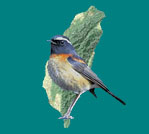 |
|
||||||||||||
|
|
|||||||||||||
 |
|
||||||||||||
|
|
|||||||||||||
|
Endemic Species Black-necklaced Scimitar Babbler Buffy Laughingthrush Rufous-crowned Laughingthrush Taiwan Fulvetta Taiwan Hwamei Taiwan Scimitar Babbler Taiwan Wren Babbler White-whiskered Laughingthrush
Yellow Tit
Endemic Sub-Species
Streak-breasted Scimitar-Babbler
White-browed Shortwing
More Birds in Taiwan
|
Collared Owlet Glaucidium brodiei pardalotum
Endemic subspecies The Collared Owlet is a tiny (16 cm) owl with a relatively large, rounded head and bright yellow eyes. The body may be rufous brown or grayish overall, and is extensively barred with dark brown on the back, wings, tail and sides of the upper breast. The lower breast and belly are white with distinct dark brown spots along the sides. The head is spotted with creamy buff, and there is a brown bar across the white throat. A buffy collar and two large orange and black “eyespots” are present on the back of the neck. The Collared Owlet is the smallest owl in Taiwan. The Taiwan subspecies pardalotum is darker overall than mainland forms. This little owl may be seen during the day perched in a tree and can often be located by the “mobbing” behaviour of songbirds in the forest. The Collared Owlet may hunt at all hours of the day, but is most active at dusk and at night, watching and listening from a high perch for its prey of small birds, rodents, lizards and large insects. It flies with very rapid wingbeats and is capable of taking prey much larger than itself, such as barbets or large rodents. Its call may be described as a mellow whistled “toot, toot-toot, toot” or “pho, pho-pho, pho”. The Collared Owlet nests in a tree cavity, in which the female usually lays four white eggs, and both adults feed the nestlings. In Taiwan the Collared Owlet is a common year-round resident in forests and at forest edges.
References: : Handbook of Birds of the World Vol. 5; A Field Guide to the Birds of China (Mackinnon and Phillipps); 100 Common Birds of Taiwan (Wild Bird Society of Taipei); N. J. Collar, “Endemic subspecies of Taiwan birds—first impressions”, in Birding ASIA, Number 2, December 2004
|